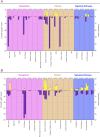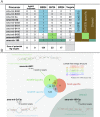Sympatric versus allopatric evolutionary contexts shape differential immune response in Biomphalaria / Schistosoma interaction
- PMID: 30893368
- PMCID: PMC6443186
- DOI: 10.1371/journal.ppat.1007647
Sympatric versus allopatric evolutionary contexts shape differential immune response in Biomphalaria / Schistosoma interaction
Abstract
Selective pressures between hosts and their parasites can result in reciprocal evolution or adaptation of specific life history traits. Local adaptation of resident hosts and parasites should lead to increase parasite infectivity/virulence (higher compatibility) when infecting hosts from the same location (in sympatry) than from a foreign location (in allopatry). Analysis of geographic variations in compatibility phenotypes is the most common proxy used to infer local adaptation. However, in some cases, allopatric host-parasite systems demonstrate similar or greater compatibility than in sympatry. In such cases, the potential for local adaptation remains unclear. Here, we study the interaction between Schistosoma and its vector snail Biomphalaria in which such discrepancy in local versus foreign compatibility phenotype has been reported. Herein, we aim at bridging this gap of knowledge by comparing life history traits (immune cellular response, host mortality, and parasite growth) and molecular responses in highly compatible sympatric and allopatric Schistosoma/Biomphalaria interactions originating from different geographic localities (Brazil, Venezuela and Burundi). We found that despite displaying similar prevalence phenotypes, sympatric schistosomes triggered a rapid immune suppression (dual-RNAseq analyses) in the snails within 24h post infection, whereas infection by allopatric schistosomes (regardless of the species) was associated with immune cell proliferation and triggered a non-specific generalized immune response after 96h. We observed that, sympatric schistosomes grow more rapidly. Finally, we identify miRNAs differentially expressed by Schistosoma mansoni that target host immune genes and could be responsible for hijacking the host immune response during the sympatric interaction. We show that despite having similar prevalence phenotypes, sympatric and allopatric snail-Schistosoma interactions displayed strong differences in their immunobiological molecular dialogue. Understanding the mechanisms allowing parasites to adapt rapidly and efficiently to new hosts is critical to control disease emergence and risks of Schistosomiasis outbreaks.
Conflict of interest statement
The authors have declared that no competing interests exist.
Figures







Similar articles
-
Compatibility Polymorphism Based on Long-Term Host-Parasite Relationships: Cross Talking Between Biomphalaria glabrata and the Trematode Schistosoma mansoni From Endemic Areas in Brazil.Front Immunol. 2019 Apr 9;10:328. doi: 10.3389/fimmu.2019.00328. eCollection 2019. Front Immunol. 2019. PMID: 31024517 Free PMC article.
-
Field-derived Schistosoma mansoni and Biomphalaria pfeifferi in Kenya: a compatible association characterized by lack of strong local adaptation, and presence of some snails able to persistently produce cercariae for over a year.Parasit Vectors. 2014 Nov 26;7:533. doi: 10.1186/s13071-014-0533-3. Parasit Vectors. 2014. PMID: 25425455 Free PMC article.
-
Compatibility of one Brazilian and two Venezuelan strains of Schistosoma mansoni with various strains of Biomphalaria glabrata.Parasitol Res. 1993;79(6):508-11. doi: 10.1007/BF00931593. Parasitol Res. 1993. PMID: 8415568
-
Immuno-molecular profile for Biomphalaria glabrata/Schistosoma mansoni interaction.Dev Comp Immunol. 2024 Jan;150:105083. doi: 10.1016/j.dci.2023.105083. Epub 2023 Oct 17. Dev Comp Immunol. 2024. PMID: 37852455 Review.
-
Integrated multi-omic analyses in Biomphalaria-Schistosoma dialogue reveal the immunobiological significance of FREP-SmPoMuc interaction.Dev Comp Immunol. 2017 Oct;75:16-27. doi: 10.1016/j.dci.2017.02.025. Epub 2017 Feb 28. Dev Comp Immunol. 2017. PMID: 28257854 Review.
Cited by
-
No evidence for schistosome parasite fitness trade-offs in the intermediate and definitive host.Parasit Vectors. 2023 Apr 17;16(1):132. doi: 10.1186/s13071-023-05730-3. Parasit Vectors. 2023. PMID: 37069704 Free PMC article.
-
Striking differences in virulence, transmission and sporocyst growth dynamics between two schistosome populations.Parasit Vectors. 2019 Oct 16;12(1):485. doi: 10.1186/s13071-019-3741-z. Parasit Vectors. 2019. PMID: 31619284 Free PMC article.
-
Single cell RNA sequencing reveals hemocyte heterogeneity in Biomphalaria glabrata: Plasticity over diversity.Front Immunol. 2022 Sep 5;13:956871. doi: 10.3389/fimmu.2022.956871. eCollection 2022. Front Immunol. 2022. PMID: 36131936 Free PMC article.
-
Experimental Infection of the Biomphalaria glabrata Vector Snail by Schistosoma mansoni Parasites Drives Snail Microbiota Dysbiosis.Microorganisms. 2021 May 18;9(5):1084. doi: 10.3390/microorganisms9051084. Microorganisms. 2021. PMID: 34070104 Free PMC article.
-
A Sustained Immune Response Supports Long-Term Antiviral Immune Priming in the Pacific Oyster, Crassostrea gigas.mBio. 2020 Mar 10;11(2):e02777-19. doi: 10.1128/mBio.02777-19. mBio. 2020. PMID: 32156821 Free PMC article.
References
-
- WHO. Schistosomiasis Fact Sheet No 115 World Health Organisation; 2010.
-
- Basch PF. Intermediate host specificity in Schistosoma mansoni. Experimental Parasitology. 1976;39(1):150–69. - PubMed
-
- Theron A, Rognon A, Gourbal B, Mitta G. Multi-parasite host susceptibility and multi-host parasite infectivity: a new approach of the Biomphalaria glabrata/Schistosoma mansoni compatibility polymorphism. Infection Genetics and Evolution. 2014;26:80–8. - PubMed
-
- Prugnolle F, de Meeus T, Pointier JP, Durand P, Rognon A, Theron A. Geographical variations in infectivity and susceptibility in the host-parasite system Schistosoma mansoni/Biomphalaria glabrata: no evidence for local adaptation. Parasitology. 2006;133(Pt 3):313–9. 10.1017/S0031182006000412 - DOI - PubMed
Publication types
MeSH terms
LinkOut - more resources
Full Text Sources
Research Materials
Miscellaneous

